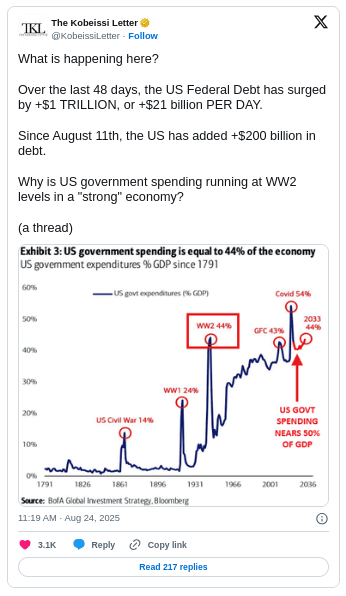Two months after Elon Musk criticized the Trump administration's handling of the national debt, reports indicate that the US added another trillion dollars to the federal debt in just 48 days.
Deficit spending has become the largest driver of the macro economy, with minimal public interest. Bitcoin, Ethereum, and decentralized finance (DeFi) are no longer just speculative; they serve as structural hedges against dysfunction in the financial system.
Is the US debt spiral related to spending or interest rates?
This increase translates to about $21 billion daily. This confirms what analysts and investors, such as Elon Musk, warned earlier: that the fiat currency system is on an unsustainable path and that digital assets may represent a hedge.
In a look back, Elon Musk specifically pointed to the recently signed One Big Beautiful Bill Act as crucial in amplifying the already concerning deficit.
However, since August 11, US debt has risen by $200 billion, bringing the national total to nearly $38 trillion.
Washington recorded a deficit of $291 billion in July alone, the second-largest deficit ever recorded. The deficit stands at $1.63 trillion for the fiscal year 2025, an increase of 7.4% year over year, and is expected to exceed $2 trillion.
Similarly, government spending rose to 44% of GDP, a level only seen during World War II and the 2008 financial crisis.
While the Federal Reserve still insists on a soft landing, the core numbers indicate a darker situation. Income is growing at only 2.5% annually, while spending increased by about 10% last month.
"It's a spending problem, not an interest rate problem... It's a spending crisis," analysts from 'Kobisi Letter' clarified.
This comment indicates that the annual deficit will remain in the trillions of dollars even if the Federal Reserve cuts interest rates.

Impacts on the cryptocurrency market and financial markets
Bond markets are already showing warning signs. Investors are demanding higher yields on US treasury bonds, with recent auction yields exceeding 5%, a rare occurrence in modern history.
As the pace of refinancing debt accelerates at higher rates, the financial deficit deepens. This presents somewhat technical forecasts for stocks and commodities, especially cryptocurrencies.
In the short term, rising yields may drain liquidity from risky assets. However, in the long term, continued deficit spending undermines trust in fiat currencies. Bitcoin has historically benefited from this trend while limiting digital assets.
While cryptocurrency traders often depict Bitcoin as digital gold, this argument is strengthened when fiat systems prove to be financially unsustainable.
They added, "In our current financial trajectory, there is a 100% certainty regarding the long-term bankruptcy of the United States."
For many in the cryptocurrency sector, the trajectory of US debt validates the thesis that decentralized assets provide protection against sovereign financial mismanagement.
With looming debt of $38 trillion and an annual deficit exceeding $1.5 trillion, the temptation for future policymakers to inflate commitments is growing. This risk reinforces the narrative of Bitcoin's scarcity.
Alternative currencies can also benefit indirectly as institutional specialists explore alternatives to low-yield treasury bonds.
Follow us for daily and comprehensive updates on Bitcoin, Ethereum, and other currencies.
#Chainbase @Chainbase Official